Repurposing Diabetes Drugs for Alzheimer's Disease Treatment
27 Pages9873 Words135 Views
Added on 2023-04-24
About This Document
This research study explores the link between diabetes and Alzheimer's disease and how certain antidiabetic drugs can be used to treat AD. It provides an overview of the epidemiology and etiology of AD, as well as the standard of care and novel experimental therapies for AD. The study also discusses the link between T2D drugs and efficacy for AD, and describes the mechanism of action of T2D drugs individually. Desklib offers solved assignments, essays, and dissertations on this topic.
Repurposing Diabetes Drugs for Alzheimer's Disease Treatment
Added on 2023-04-24
ShareRelated Documents
1
Title: Repurposing diabetes drugs as treatments for Alzheimer's Disease
Title: Repurposing diabetes drugs as treatments for Alzheimer's Disease
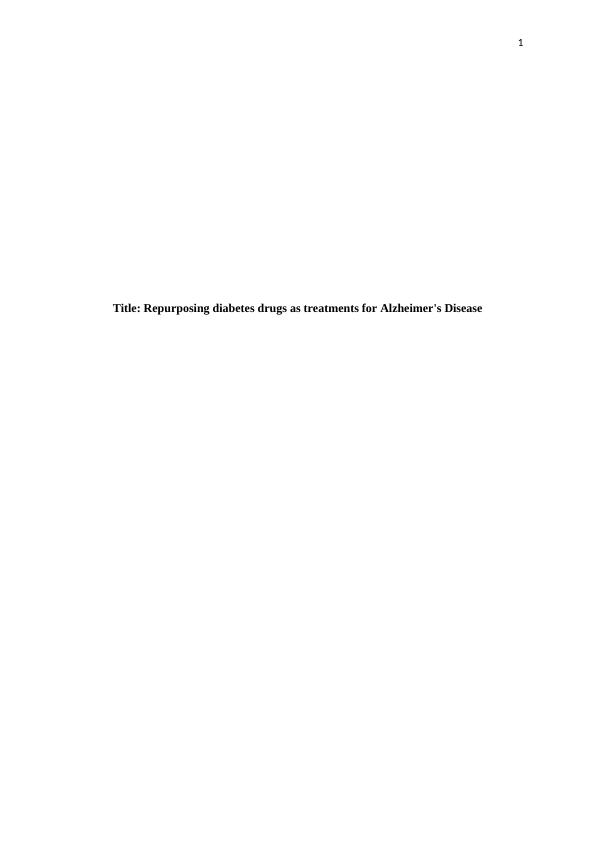
2
Abstract
The research topic basically captures the association that exists between Alzheimer disease
and diabetes. Both of these conditions have an adverse impact on the health and well-being of
many people all around the globe. The research study primarily captures how certain anti-
diabetic drugs can be used for the purpose of treating AD in individuals. A thorough and
detailed insight has been provided onto both of the health conditions in order to show the link
that connects both of them. The key connection between diabetes and Alzheimer disease
arises due to insulin resistance and deficiency. The research study has been designed to
address how diabetic drugs can be used for the purpose of treating Alzheimer disease in
individuals.
Introduction
Type 2 diabetes and Alzheimer disease (AD) are considered as the two most common
diseases in the aging population. It has been estimated that around 5.4 million people in
United States suffer from AD and the risk of this disease increase with the age. According to
the study of Yarchoan & Arnold, (2014), one in the eight people above the age of 65 and
every one in two people above the age of 85 years suffer from AD. WHO has also recognised
the increasing complexity of the dementia and have also acknowledged that all countries
should consider dementia as a critical public health problem. AD is considered as the most
common form of dementia, in which people suffer from progressive deterioration of memory
along with other problems related to cognitive functioning (Lee & Krishnan, 2010). The
report of WHO has identified that “In Singapore, the number of people afflicted by the
condition is expected to rise from about 22,000 currently to about 53,000 in 2020 and
187,000 in 2050” (WHO, 2017, p. 2).
Similarly, the occurrence of type 2 diabetes among the population is also very high. Yarchoan
& Arnold, (2014) have identified that around 90% of the aging population of US suffer from
type 2 diabetes and similar statistics have been identified in other developing nations as well.
Therefore type 2 diabetes and AD are significant public health issues that affect the quality of
life of the individuals. Akter et al. (2011) has argued that there is a significant link between
diabetes and Alzheimer disease, as they result in many social and health related
consequences.
Abstract
The research topic basically captures the association that exists between Alzheimer disease
and diabetes. Both of these conditions have an adverse impact on the health and well-being of
many people all around the globe. The research study primarily captures how certain anti-
diabetic drugs can be used for the purpose of treating AD in individuals. A thorough and
detailed insight has been provided onto both of the health conditions in order to show the link
that connects both of them. The key connection between diabetes and Alzheimer disease
arises due to insulin resistance and deficiency. The research study has been designed to
address how diabetic drugs can be used for the purpose of treating Alzheimer disease in
individuals.
Introduction
Type 2 diabetes and Alzheimer disease (AD) are considered as the two most common
diseases in the aging population. It has been estimated that around 5.4 million people in
United States suffer from AD and the risk of this disease increase with the age. According to
the study of Yarchoan & Arnold, (2014), one in the eight people above the age of 65 and
every one in two people above the age of 85 years suffer from AD. WHO has also recognised
the increasing complexity of the dementia and have also acknowledged that all countries
should consider dementia as a critical public health problem. AD is considered as the most
common form of dementia, in which people suffer from progressive deterioration of memory
along with other problems related to cognitive functioning (Lee & Krishnan, 2010). The
report of WHO has identified that “In Singapore, the number of people afflicted by the
condition is expected to rise from about 22,000 currently to about 53,000 in 2020 and
187,000 in 2050” (WHO, 2017, p. 2).
Similarly, the occurrence of type 2 diabetes among the population is also very high. Yarchoan
& Arnold, (2014) have identified that around 90% of the aging population of US suffer from
type 2 diabetes and similar statistics have been identified in other developing nations as well.
Therefore type 2 diabetes and AD are significant public health issues that affect the quality of
life of the individuals. Akter et al. (2011) has argued that there is a significant link between
diabetes and Alzheimer disease, as they result in many social and health related
consequences.
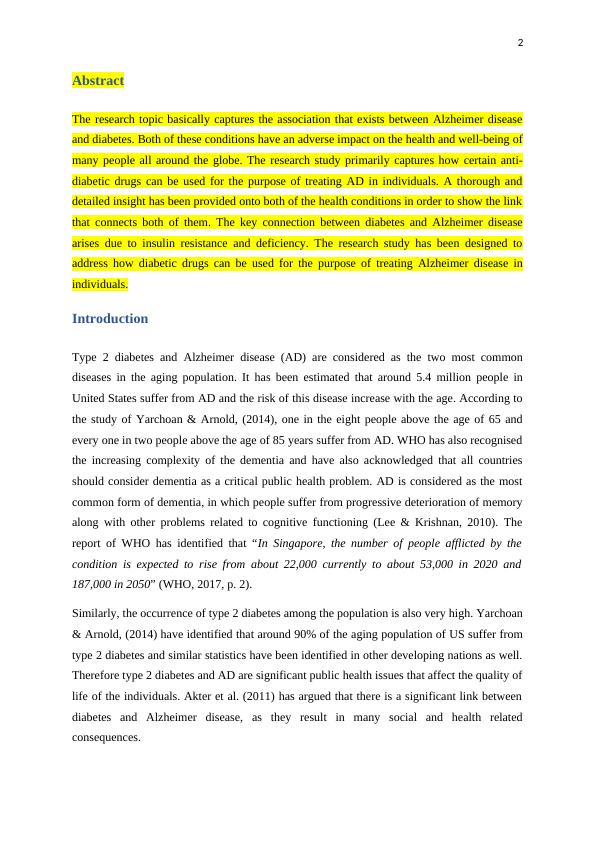
3
Epidemiology of Alzheimer disease
According to the study of Reitz, Brayne, & Mayeux, (2011), more than 25 million people all
over the world suffer from dementia and the most common form of dementia is Alzheimer's
disease. In developed, as well as developing nations, Alzheimer's disease has significant
consequences and significantly affect the individuals, caregivers and healthcare providers.
According to the report of Alzheimer Disease Association Singapore, dementia is a
progressive intellectual decline and it has been identified that in the year 2018 around 50
million people around the world were affected by dementia. This number is also expected to
increase to 82 million 2030 and 152 million by 2050 (Alzheimer Disease Association, 2018).
According to this information around 82,000 people in the year 2018 will be affected by
dementia and this number can increase to 1000,000 in few years (Alzheimer Disease
Association, 2018). The financial strain caused by the disease worldwide is very high and had
cost around US$1 trillion. According to the study of Woo, Thompson, & Magadi (2017), in
Singapore, dementia has resulted in costing S$2.8 billion in the year 2015, which is estimated
to increase three time by 2030.
Qiu, Kivipelto, & von Strauss, (2009) have identified that most of the people suffering with
dementia around the world are mainly suffering from AD and there is an increase of 5 million
cases every year. The WiSE study conducted by Subramaniam et al. (2015), conducted a
comprehensive single phase, cross-sectional, epidemiological survey for understanding the
prevalence of dementia and Ad in Singapore. The study adopted the 10/66 protocol with the
Diagnostic and Statistical Manual of mental disorders -fourth edition (DSM-IV) for the
diagnosis of dementia among the population. According to the results of the study of), it was
identified that prevalence of 10/66 dementia is 10% in the older population (75 years and
above), while the prevalence of DSM-IV dementia was found to be 4.6%. The WiSE study
the likelihood of dementia increases with age. such as “for those aged 75–84 years was 4.3
times and for those 85 years and over, it was 18.4 times higher compared to that of elderly
aged 60–74 years” (Institute of Mental Health, 2015b, p. 1).
Etiology of Alzheimer’s Disease
Alzheimer’s Disease is considered as the most common form of dementia. This disease is
mainly characterised by the mitochondrial impairment, oxidative stress, synaptic dysfunction
and disruption of the blood brain barrier. This impairment are mainly caused by the abnormal
Epidemiology of Alzheimer disease
According to the study of Reitz, Brayne, & Mayeux, (2011), more than 25 million people all
over the world suffer from dementia and the most common form of dementia is Alzheimer's
disease. In developed, as well as developing nations, Alzheimer's disease has significant
consequences and significantly affect the individuals, caregivers and healthcare providers.
According to the report of Alzheimer Disease Association Singapore, dementia is a
progressive intellectual decline and it has been identified that in the year 2018 around 50
million people around the world were affected by dementia. This number is also expected to
increase to 82 million 2030 and 152 million by 2050 (Alzheimer Disease Association, 2018).
According to this information around 82,000 people in the year 2018 will be affected by
dementia and this number can increase to 1000,000 in few years (Alzheimer Disease
Association, 2018). The financial strain caused by the disease worldwide is very high and had
cost around US$1 trillion. According to the study of Woo, Thompson, & Magadi (2017), in
Singapore, dementia has resulted in costing S$2.8 billion in the year 2015, which is estimated
to increase three time by 2030.
Qiu, Kivipelto, & von Strauss, (2009) have identified that most of the people suffering with
dementia around the world are mainly suffering from AD and there is an increase of 5 million
cases every year. The WiSE study conducted by Subramaniam et al. (2015), conducted a
comprehensive single phase, cross-sectional, epidemiological survey for understanding the
prevalence of dementia and Ad in Singapore. The study adopted the 10/66 protocol with the
Diagnostic and Statistical Manual of mental disorders -fourth edition (DSM-IV) for the
diagnosis of dementia among the population. According to the results of the study of), it was
identified that prevalence of 10/66 dementia is 10% in the older population (75 years and
above), while the prevalence of DSM-IV dementia was found to be 4.6%. The WiSE study
the likelihood of dementia increases with age. such as “for those aged 75–84 years was 4.3
times and for those 85 years and over, it was 18.4 times higher compared to that of elderly
aged 60–74 years” (Institute of Mental Health, 2015b, p. 1).
Etiology of Alzheimer’s Disease
Alzheimer’s Disease is considered as the most common form of dementia. This disease is
mainly characterised by the mitochondrial impairment, oxidative stress, synaptic dysfunction
and disruption of the blood brain barrier. This impairment are mainly caused by the abnormal
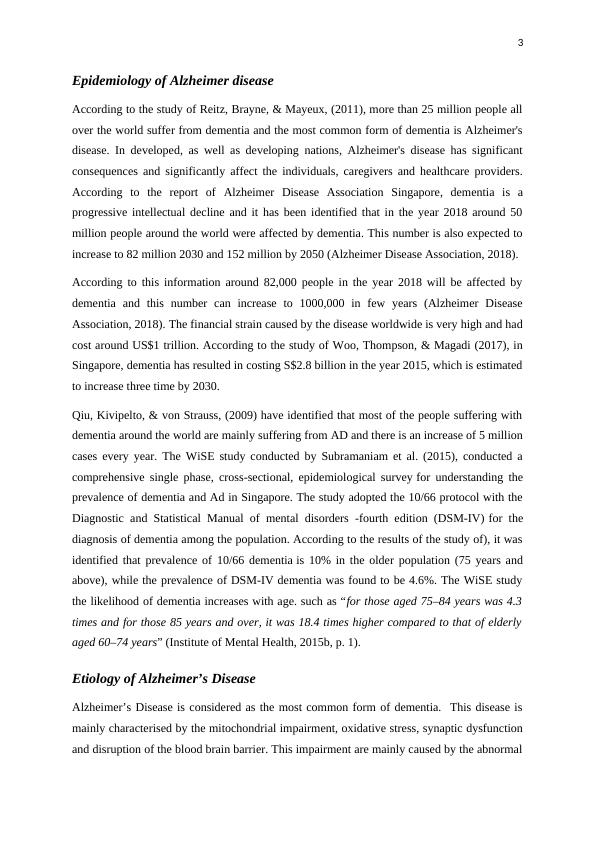
4
extracellular accumulation of amyloid-β peptide (Aβ) in the form of amyloid plaques and
aggregation of tau protein in intracellular neuro fibrillary tangles (NFTs) (Reitz, Brayne, &
Mayeux, 2011), which are considered as the hallmark of AD causing neuronal and synaptic
loss, increasing cognitive dysfunctions, loss of memory and normal body functions.
According to the study of Peric and Annaert, (2015), Ad could be of two types based on the
age of onset and pathological factors.
Another hypothesis is Tau protein deposition in the insoluble forms results in the loss of tau
function. This further results in instability of microtubule and promotes neurodegeneration.
Studies have identified that microtubule instability is a significant reason of AD (Kalra, and
Khan, 2015). Therefore, there are some significant causes of neurodegenerative disorder, that
may include genetic mutation, misfolding of protein, generation of the toxic molecules and
oxidative stress, mitochondrial dysfunction, neuro-inflammatory process and protein
degradation pathways. All of these causes are also associated with type 2 diabetes and its
pathological conditions.
Pathology of AD
Dementia is a disorder that is characterised by the deterioration of the cognitive functioning
and increasing behavioural problems. Alzheimer disease (AD) is considered as the most
common cause of Dementia. According to the study of Perry and Perry (2015) the pathology
of AD largely remains a mystery for most of the scholars and scientists. More focus has been
placed on brain, while the disease mainly takes place on cellular level. According to the study
of Reitz, Brayne, & Mayeux, (2011), the main pathological change that has been identified in
the AD brain tissue are that the level of both amyloid-β (Aβ) peptide is increased, which is
deposited extracellularly in diffuse and neuritic plaques. Also, hyperphosphory-lated tau (p-
tau), which is a microtubule assembly protein that mainly accumulated intercellularly as
neurofibrillary tangles (nFts) (Reitz, Brayne, & Mayeux, 2011).
Perry and Perry (2015) have also identified that molecular changes occurring due to aging in
the individuals led to altering the metabolism and biochemistry of individual pathways.
Addition to these pathologies, AD is also characterised by the widespread loss of synapses
and neurons. According to Ferrarelli (2018), Alzheimer’s disease (AD) is a complex
neurodegenerative disease, which is further characterised by the progressive loss of cognitive
functioning and dementia. Ferrarelli (2018) argued that “formation of plaques (focal
aggregates) of the protein amyloid-β (Aβ) in the brain is frequently observed in AD patients,
extracellular accumulation of amyloid-β peptide (Aβ) in the form of amyloid plaques and
aggregation of tau protein in intracellular neuro fibrillary tangles (NFTs) (Reitz, Brayne, &
Mayeux, 2011), which are considered as the hallmark of AD causing neuronal and synaptic
loss, increasing cognitive dysfunctions, loss of memory and normal body functions.
According to the study of Peric and Annaert, (2015), Ad could be of two types based on the
age of onset and pathological factors.
Another hypothesis is Tau protein deposition in the insoluble forms results in the loss of tau
function. This further results in instability of microtubule and promotes neurodegeneration.
Studies have identified that microtubule instability is a significant reason of AD (Kalra, and
Khan, 2015). Therefore, there are some significant causes of neurodegenerative disorder, that
may include genetic mutation, misfolding of protein, generation of the toxic molecules and
oxidative stress, mitochondrial dysfunction, neuro-inflammatory process and protein
degradation pathways. All of these causes are also associated with type 2 diabetes and its
pathological conditions.
Pathology of AD
Dementia is a disorder that is characterised by the deterioration of the cognitive functioning
and increasing behavioural problems. Alzheimer disease (AD) is considered as the most
common cause of Dementia. According to the study of Perry and Perry (2015) the pathology
of AD largely remains a mystery for most of the scholars and scientists. More focus has been
placed on brain, while the disease mainly takes place on cellular level. According to the study
of Reitz, Brayne, & Mayeux, (2011), the main pathological change that has been identified in
the AD brain tissue are that the level of both amyloid-β (Aβ) peptide is increased, which is
deposited extracellularly in diffuse and neuritic plaques. Also, hyperphosphory-lated tau (p-
tau), which is a microtubule assembly protein that mainly accumulated intercellularly as
neurofibrillary tangles (nFts) (Reitz, Brayne, & Mayeux, 2011).
Perry and Perry (2015) have also identified that molecular changes occurring due to aging in
the individuals led to altering the metabolism and biochemistry of individual pathways.
Addition to these pathologies, AD is also characterised by the widespread loss of synapses
and neurons. According to Ferrarelli (2018), Alzheimer’s disease (AD) is a complex
neurodegenerative disease, which is further characterised by the progressive loss of cognitive
functioning and dementia. Ferrarelli (2018) argued that “formation of plaques (focal
aggregates) of the protein amyloid-β (Aβ) in the brain is frequently observed in AD patients,
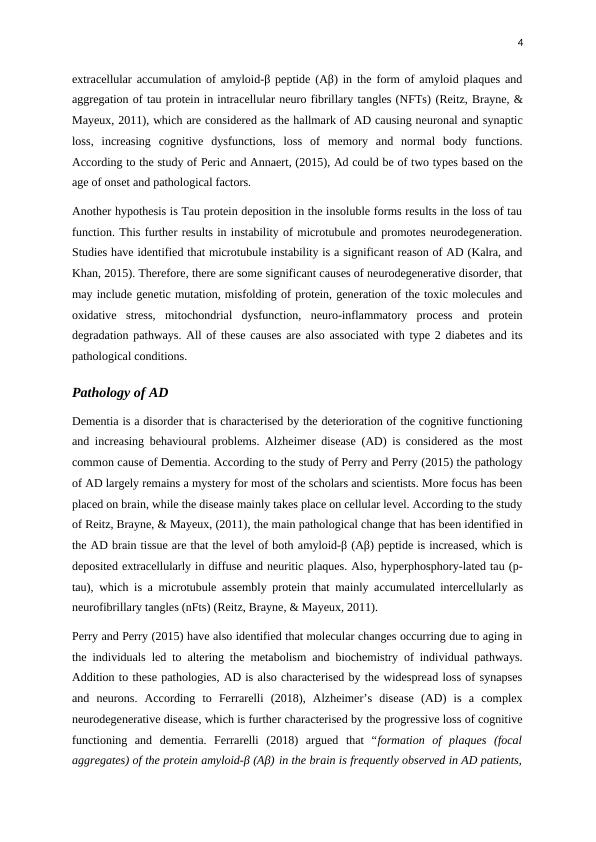
5
as are acetylation and aggregation of the protein tau and loss of the prolyl isomerase Pin1”
(p. 1).
Standard of care / therapies for AD
Cholinesterase inhibitors is considered as the most significant part for the treatment of the
patients suffering with AD. For the treatment of mild to moderate AD, four drugs have been
approved including, donepezil, galantamine, rivastig-mine, and tacrine (Apostolova 2016).
This therapy is also considered as significant standard of care for the patients suffering with
AD. The ChEIs are considered as clinically beneficial in the double blinded, placebo control
trials. However, the recent reviews have informed that ChEIs including rivastigmine and
galantamine do not have much clinical benefits than donepezil. The recent studies have
shown that Acetylcholinesterase inhibitors (AChEIs) and memantine remain the only
important drugs that are used for the treatment of AD. It is also required that patient continue
these therapies for long terms for benefits, as the benefits can be seen on the severe level of
the illness as well (Bishara et al. 2015).
Novel experimental therapies for AD
According to the evidences, Alzheimer's disease (AD) is considered as a significant
healthcare problem in the developed and developing nations. The novel treatments and
pharmacotherapies are mainly based on the amyloidogenic hypothesis of AD, which informs
that beta amyloid (Aβ) peptide is mainly responsible for cognitive impairment in patients
with AD (Mahajan 2015). Therefore, the main goal of the novel treatment approaches is to
reduce the production of Aβ through the inhibition of β and γ secretase enzymes and to
enhance the mechanism of dissolution of the existing cerebral Aβ plaques (Folch et al. 2016).
The novel treatment strategies include cleavage of amyloid precursor protein (APP) by α-
secretase, which is also considered as the disease modifying strategy for AD (Mahajan 2015).
Link between T2D drugs and efficacy for AD
There are various studies that have provided the epidemiological evidences linking type 2
diabetes and its related conditions, like obesity, metabolic syndrome and hyperinsulinemia,
with Alzheimer’s disease (Beydoun et al. 2008; Li, Song, & Leng 2015). The main link of
type 2 diabetes and AD is associated with insulin resistance and deficiency. The first clue that
informs that how the brain may become insulin resistant in AD explains that Aβ oligomers
as are acetylation and aggregation of the protein tau and loss of the prolyl isomerase Pin1”
(p. 1).
Standard of care / therapies for AD
Cholinesterase inhibitors is considered as the most significant part for the treatment of the
patients suffering with AD. For the treatment of mild to moderate AD, four drugs have been
approved including, donepezil, galantamine, rivastig-mine, and tacrine (Apostolova 2016).
This therapy is also considered as significant standard of care for the patients suffering with
AD. The ChEIs are considered as clinically beneficial in the double blinded, placebo control
trials. However, the recent reviews have informed that ChEIs including rivastigmine and
galantamine do not have much clinical benefits than donepezil. The recent studies have
shown that Acetylcholinesterase inhibitors (AChEIs) and memantine remain the only
important drugs that are used for the treatment of AD. It is also required that patient continue
these therapies for long terms for benefits, as the benefits can be seen on the severe level of
the illness as well (Bishara et al. 2015).
Novel experimental therapies for AD
According to the evidences, Alzheimer's disease (AD) is considered as a significant
healthcare problem in the developed and developing nations. The novel treatments and
pharmacotherapies are mainly based on the amyloidogenic hypothesis of AD, which informs
that beta amyloid (Aβ) peptide is mainly responsible for cognitive impairment in patients
with AD (Mahajan 2015). Therefore, the main goal of the novel treatment approaches is to
reduce the production of Aβ through the inhibition of β and γ secretase enzymes and to
enhance the mechanism of dissolution of the existing cerebral Aβ plaques (Folch et al. 2016).
The novel treatment strategies include cleavage of amyloid precursor protein (APP) by α-
secretase, which is also considered as the disease modifying strategy for AD (Mahajan 2015).
Link between T2D drugs and efficacy for AD
There are various studies that have provided the epidemiological evidences linking type 2
diabetes and its related conditions, like obesity, metabolic syndrome and hyperinsulinemia,
with Alzheimer’s disease (Beydoun et al. 2008; Li, Song, & Leng 2015). The main link of
type 2 diabetes and AD is associated with insulin resistance and deficiency. The first clue that
informs that how the brain may become insulin resistant in AD explains that Aβ oligomers
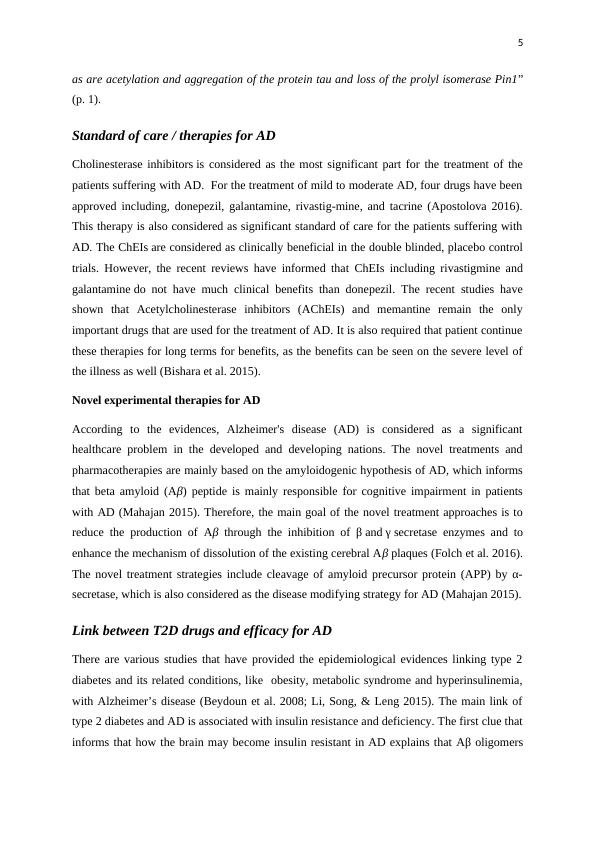
6
get binds to hippocampal neurons and results in triggering the dendritic insulin receptor
substrates (IRs) from the plasma membrane (Zhao et al 2008), which was significantly
identified in the brain of the individual suffering from AD (Moloney et al. 2010).
Some important characteristics of type 2 diabetes identified in the diabetic patients include
lower levels of insulin, IGF and IRs, which were also observed the results of neuropathology
of the patients suffering with AD (Craft 2012). Another significant link between AD and type
2 diabetes is clear with the significant increase in the biomarkers if the peripheral insulin
resistance in the hippocampus of non-diabetic AD patients identified by Talbot et al (2012).
Similarly, LI, SONG, AND LENG, (2015) have identified that abnormal activation of the
TNF-α/c-Jun N-terminal kinase pathway and inhibition of IRs-1 in cultured hippocampal
neurons is caused by Aβ oligomers in Ad patients (Arnold et al. 2018). Some of the scholars
have also considered that AD could be characterised as the “insulin resistant brain state” or
even as the “type 3 diabetes” (Bekkering et al. 2013).
Figure 1: Role of Insulin Resistance and Insulin Deficiency in Pathology of AD (Li,
Song, And Leng, 2015)
According to the study of Devi et al (2012), the accumulation of Aβ is accelerated by the
streptozotocin-induced insulin-deficient diabetes. This take place through the translational
upregulation of the β-secretase enzyme, BACE1, and its substrate, amyloid precursor protein,
in a transgenic mouse model of AD identified by Devi et al (2012). Another potential link
between the mechanism of the type 2 diabetes and AD is the interference of insulin with
extracellular proteolytic Aβ degradation occurs via the insulin-degrading enzyme, which also
further results in catabolising the IGF and insulin (Devi et al 2012; Moloney et al 2010; Li,
Song, And Leng, 2015). Under the type 2 diabetes and insulin resistance condition, it has
been identified that insulin can result in inhabiting the insulin-degrading enzyme and may
result in degradation of the Aβ, resulting in increasing neurotoxicity and increasing AD.
Besides affecting Aβ, insulin deficiency and insulin resistance can also result in increasing
get binds to hippocampal neurons and results in triggering the dendritic insulin receptor
substrates (IRs) from the plasma membrane (Zhao et al 2008), which was significantly
identified in the brain of the individual suffering from AD (Moloney et al. 2010).
Some important characteristics of type 2 diabetes identified in the diabetic patients include
lower levels of insulin, IGF and IRs, which were also observed the results of neuropathology
of the patients suffering with AD (Craft 2012). Another significant link between AD and type
2 diabetes is clear with the significant increase in the biomarkers if the peripheral insulin
resistance in the hippocampus of non-diabetic AD patients identified by Talbot et al (2012).
Similarly, LI, SONG, AND LENG, (2015) have identified that abnormal activation of the
TNF-α/c-Jun N-terminal kinase pathway and inhibition of IRs-1 in cultured hippocampal
neurons is caused by Aβ oligomers in Ad patients (Arnold et al. 2018). Some of the scholars
have also considered that AD could be characterised as the “insulin resistant brain state” or
even as the “type 3 diabetes” (Bekkering et al. 2013).
Figure 1: Role of Insulin Resistance and Insulin Deficiency in Pathology of AD (Li,
Song, And Leng, 2015)
According to the study of Devi et al (2012), the accumulation of Aβ is accelerated by the
streptozotocin-induced insulin-deficient diabetes. This take place through the translational
upregulation of the β-secretase enzyme, BACE1, and its substrate, amyloid precursor protein,
in a transgenic mouse model of AD identified by Devi et al (2012). Another potential link
between the mechanism of the type 2 diabetes and AD is the interference of insulin with
extracellular proteolytic Aβ degradation occurs via the insulin-degrading enzyme, which also
further results in catabolising the IGF and insulin (Devi et al 2012; Moloney et al 2010; Li,
Song, And Leng, 2015). Under the type 2 diabetes and insulin resistance condition, it has
been identified that insulin can result in inhabiting the insulin-degrading enzyme and may
result in degradation of the Aβ, resulting in increasing neurotoxicity and increasing AD.
Besides affecting Aβ, insulin deficiency and insulin resistance can also result in increasing
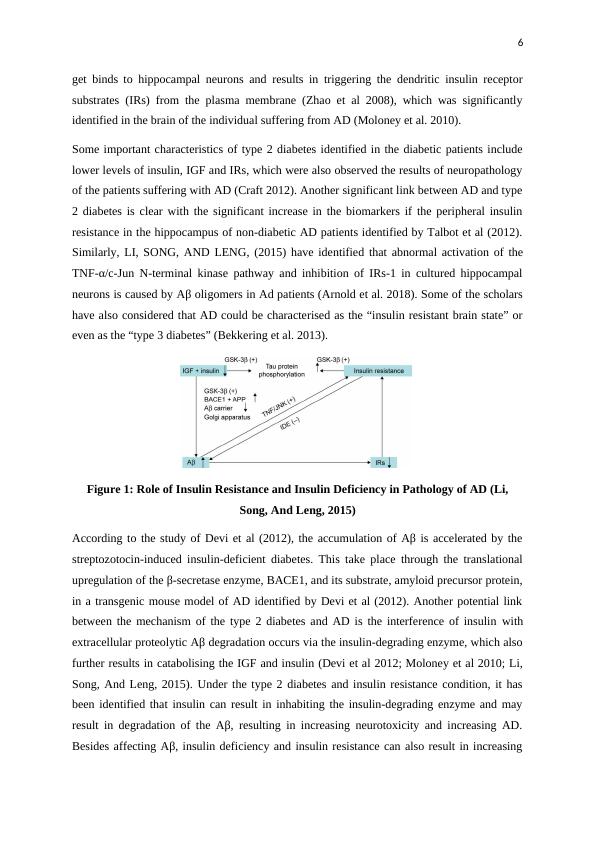
End of preview
Want to access all the pages? Upload your documents or become a member.
Related Documents
Alzheimer Dementia In UK - Presentationlg...
|18
|1670
|17
Public Health Surveillance Resultslg...
|8
|1958
|23
Academic Report On Dementia And Diabetieslg...
|15
|3779
|11
PUBLIC HEALTH. PUBLIC HEALTH. 1. 1. : PUBLIC HEALTH. PUlg...
|3
|494
|53
Assessment and Consultation in Clinical Settingslg...
|16
|4979
|42
Benefits of Music Therapy on Dementia Patientslg...
|16
|4802
|42
